The Atmosphere of Labyrinth vs. The Dark Crystal
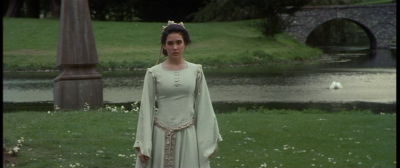
I am telling you nothing but the truth when I say that Labyrinth and The Dark Crystal are two of my favorite films. I had well-worn VHS copies of both (not even the actual VHS tapes, my dad recorded them on TV) and I can recall watching Labyrinth for the first time, hiding under a blanket when the goblins would appear, whimpering as I covered my eyes. I remember watching The Dark Crystal for the first time and fearing a lump of laundry that was reflected in my mirror, believing it to be some vulture creature. While I have Labyrinth on DVD, sadly I do not have The Dark Crystal. But I have seen it quite a few times (once in theaters around 2009) and I own The World of The Dark Crystal, because I was once a big Brian Froud fan (I have the Good Fairies, Bad Fairies book too. Shh).
Visually, both films are incredibly striking. The Dark Crystal was lauded as the first live-action film with no human beings on screen. The atmosphere is entirely alien, while Labyrinth is an alien world translated by a human ("It's not fair!"). But if there is a difference between these works, it's what clutters the screen. In Labyrinth, areas that are too clean are suspicious while in The Dark Crystal, the light beings are the bringers of renewal. In The Dark Crystal, the dirty, hunching Skeksis are evil creatures while in Labyrinth, dirt and clutter are homely. I would go as far as to say that the world of The Dark Crystal is an empty one while Labyrinth is a very cluttered world.
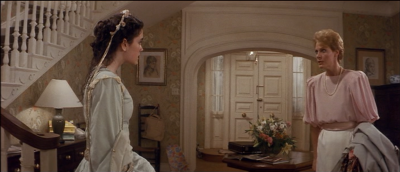
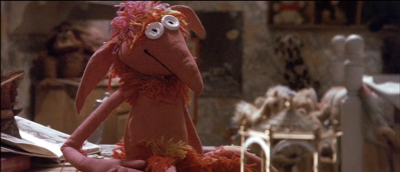
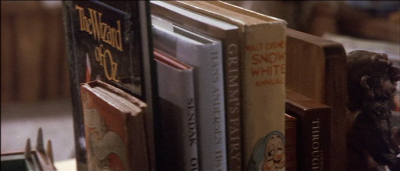
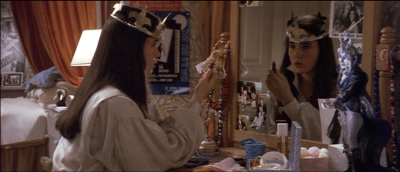
There's a reason why the atmosphere differs so much in these films, though. Labyrinth is a journey of the interior while The Dark Crystal is a journey of the exterior. Sarah is on the cusp of adulthood, but she's still a child. Her journey through the labyrinth is akin to searching through her soul for the child that will bring about understanding. There's also the task of coming to terms with that selfish nature of hers. Jen's quest is about saving the world, about returning a shard to a crystal before the world ends. By bringing the shard back to the crystal, he will also bring the Skeksis and the uRu back together, into the true beings that they are. Jen's quest is of the non-individual. While he is the hero of the story, it is the beings of light who bring life back to the planet. Sarah's quest is entirely about the individual.
Everything in Sarah's world is familiar, even in the labyrinth. Her fantasies, her toys all make up the dream world that she enters. I believe it was Sigmund Freud who once said that it is objects in our real world that make up our dreams. And since Sarah is a rather materialistic girl at the beginning, allowing her objects to define her, they create her dream world. Jen's world is that of the unfamiliar. Even he doesn't know much about the world around him, as he's been taken care of by the uRu all his life. To the audience, The Dark Crystal is an entirely alien world and this is what was really endearing for me. Very few films can achieve this effect, but it's wonderful when it works. Jen's world is lush but empty. Beautiful, but barely lived-in. Jim Henson had said that he felt The Dark Crystal got to be too heavy. When he started working on Labyrinth, he wanted something much lighter. In the end, we have two companion films, Labyrinth being about dreams and fantasy while The Dark Crystal is about nightmares and realism (at least to its world). There's something quite haunting about the atmosphere of Jen's world.
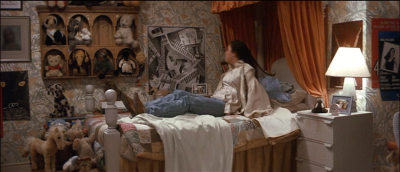
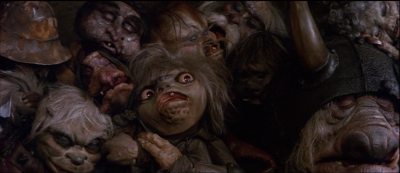
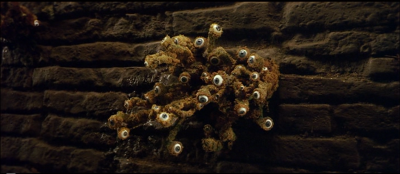

This is not to say that everything in Labyrinth is light. Sarah's quest is as difficult as Jen's. Labyrinth was originally based on a book by Maurice Sendak. In fact, the end credits give thanks to Sendak's existence. The style of the film seems to take inspiration from E.T.A. Hoffman's Bamberg and has story elements that are similar to his. Hoffman lived in a rather horrible time and he often felt guilty for the bloodshed he saw. One can see this in his stories, that his main characters are often searching for mourning, something that happened in the past that they still need to mourn for. Sarah is in a strange position; physically, she's growing rapidly, but mentally, she's still a child. And when a new baby comes to her family, she becomes quite selfish, as we all do at that age. She's not getting the attention she used to and her parents expect her to look after her younger brother. This cuts into her flights of fancy.
When the goblins egg her on to say the words, it's an extension of her id, telling her to go through with that horribly selfish act. As I've said multiple times before, the labyrinth is a physical representation of our id and our goal is to reach the center, where we'll face the beast and the maiden. Unfortunately, we know nothing about our id other than that it's incredibly selfish and far more sexually aware than we are. To reach the center is to reach insanity, but that Sarah is able to make it to the center and stand tall is quite a feat. The goblins are a manifestation of her id and I would say that Jareth is her Jungian shadow. These are all the aspects of herself that she has repressed. Her step-mother asks her if she'll ever have a date; Sarah wears make-up as part of a costume, not to attract others. Jareth represents that sexuality that she doesn't want to face just yet.
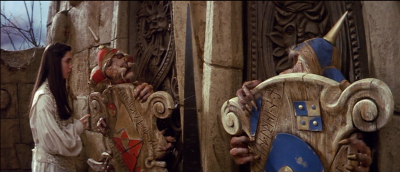
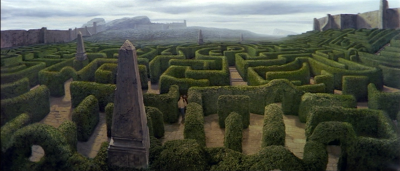
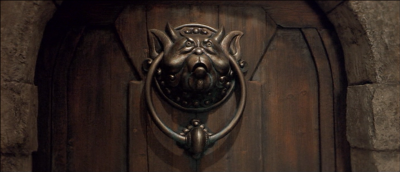
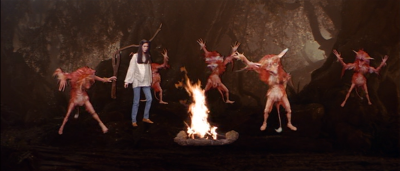
Perhaps one of the most interesting aspects of Labyrinth is that objects are often freed of their burden. Creatures are freed of their need for connective tissue, doors knockers are freed of the knocking, but they stop being useful once that has happened. This is the same for Sarah, who believes all the objects she clutters her room with make her up. Really, it's family that makes her up and she has to realize this before she loses her baby brother. By taking away her baby brother, Sarah has lost her role as protective older sister, which was essential to Maurice Sendak's story that Labyrinth was based on. In order to become a useful human being again, she has to find her brother. Much like the door knocker, which has to regain its knocker to become a useful door once again.
The labyrinth itself is an interesting setting. While it seems desolately pristine in the beginning, it's once Sarah delves in further that it's cluttered with objects. Much like a human being. We have a pristine coating, but underneath that are our fears, desires, nightmares . . . The Dark Crystal is a story about the world rather than the individual, and as such, the world is beautiful but hollow. Labyrinth features a modern setting, much like E.T.A. Hoffman's stories. He was considered to have created a new genre in the fairy tale, with fantastic happenings in modern settings. The Dark Crystal has a very primal look to it, as if a civilized race had once lived there, leaving only hints behind.
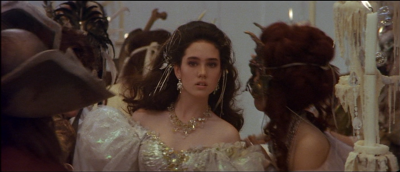
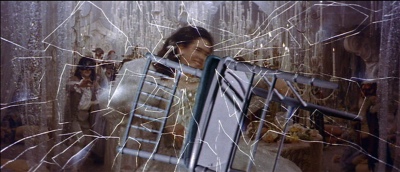
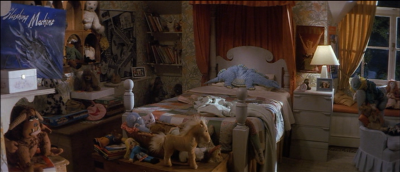
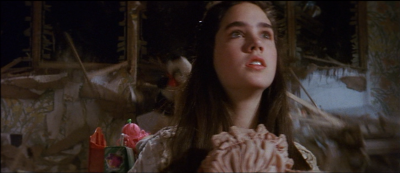
It's often Sarah's sexuality that saves her from a situation. Like the Sandman in Hoffman's story, it is Jareth who reminds Sarah of her id and thus, situations in which he tries to bring her closer leave her with an off feeling. The fantasy that he thinks she wants comes off as uncanny to Sarah. Another interesting choice in the ballroom scene is that Sarah is the only one not wearing a mask. Once she's escaped that trap, another goblin tries to trick her into believing a fake room is her room. It's only when Sarah is in front of her mirror, with lipstick, that she realizes something is wrong. These are simply costumes. The dress she wears is a princess costume and her moments sitting in front of the mirror is simply a costume of femininity. She dresses her identity in objects, but they mean nothing. "It's all junk!" Sarah proclaims, and smashes her princess doll on the floor.
The mirror works to reaffirm Sarah's fantasies and as break them down. In the mirror, she sees her face as she puts on make-up, performs fantasies in front of it. But in the mirror, she also sees the room dissolving as the illusion breaks down. Mirrors create fantasies and destroy them. For it is in a reflection that we see the truth of our image, but we are also perceiving that image through our perceptions.
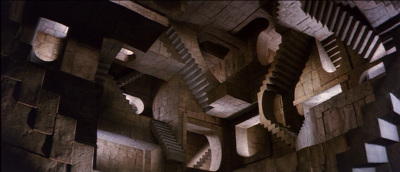
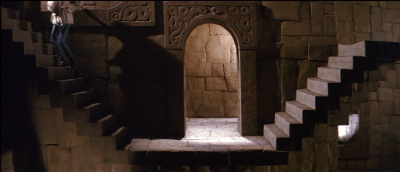
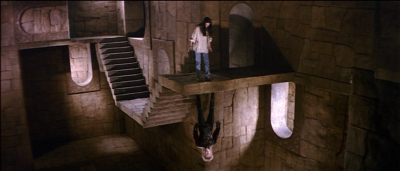
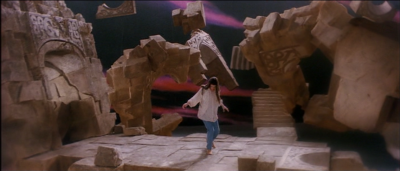
As Jen gets closer to the center of his world, everything is very structured. It's a castle, there's a certain route through the castle he has to take, and the center is the dark crystal. The center of Sarah's world has no structure. The labyrinth begins breaking down the closer she gets, to a set of strange stairs (which can be seen in her room) and finally, to blocks of stairs floating in the air. Jen's journey ends with the cost of another while Sarah's ends at the cost of herself, her selfish self at least. I like to believe that she accepts her shadow in the end. That instead of stating her dominance and taking away Jareth's power, his power is assimilated into her as a fully developed human being. For Sarah and Jareth are the only beings who can travel between the conscious and unconscious realms (Jareth as an owl, which might harken to the more animal side of our nature).
This concept of a Jungian shadow can be seen in The Dark Crystal as well. Originally, the Skeksis were designed after the seven deadly sins, with the uRu characterizing seven virtues. They are counterparts to one another and when a Skeksis dies, it's other side, it's uRu dies as well. When Jen's master dies at the beginning, a Skeksis dies. And when a Skeksis falls into a pit, one of the uRu dies. In the end, they are joined together to form light beings, incorporating both the sin and the virtue. There's hope at the end, but there's also ambiguity, something that I think Labyrinth shares as well.
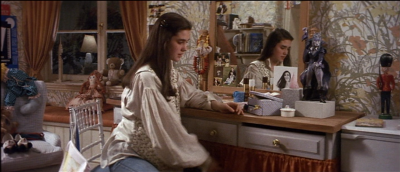
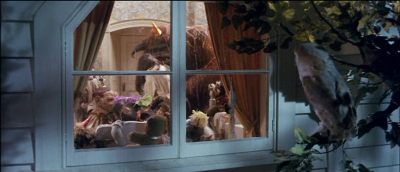
In the end, the owl is seen by her window. Sarah can never get rid of her id; she can have the illusion of power over it, but she can't cast it out of her entirely. This is the lasting impression of the film, that the id creature will always be in her no matter how hard she tries to hide it. But she can move on from this as a better person.
Sadly, Labyrinth didn't do as well in theaters as The Dark Crystal did. Though there are complaints of a paper-thin plot, I don't think that's true. The books seen in Sarah's room hint to this: Alice in Wonderland, The Wizard of Oz, various fairy tales . . . By basing the story on fairy tales, Labyrinth consequently has depth to its story. We constantly tell fairy tales because they are embedded in our collective unconscious; a part of the story tells a truth about the universal human experience. And as such, Labyrinth has more of a plot than people tend to give it. As much as I love The Dark Crystal, I think Labyrinth has more to offer on terms of plot. However, visually, I prefer The Dark Crystal. In fact, both of these films have influenced my style in many ways. Sometimes the way I want to dress characters harkens back to these movies I watched as a child.
They both offer distinct visions of an alien world, whether it be a world different from ours or the inner world of a human being. But all the same, they're both worth watching. Maybe a few times as a child and then a few times as an adult. That's certainly what I did!
Since I own the DVD, I do intend to watch what was considered a "spiritual" sequel to Labyrinth and was written by a writer I loved when I was a teenager. It is Mirrormask and my memories of it are not favorable, but who knows? Maybe age will make it better.